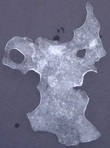Imaginary cities
The Venetian explorer Marco Polo met Kublai Khan, the first emperor of the Yuan dynasty of China, in the 1270's. Kublai Khan was impressed with Marco Polo and made him foreign emissary, after which Marco Polo traveled throughout his empire for years. Italo Calvino's quirkly 1972 novel Invisible Cities imagines Marco Polo's descriptions of the cities he finds and the conversations between the two during their meetings.
Marco Polo's descriptions of the different cities are fanciful and wildly imaginative. Many of them touch on the themes of how cities change and remake themselves. For example, in Maurilia, the traveler is invited to examine old post cards that show the city as it used to be while they stand in the identical spaces. They are constantly expected to praise the magnificence of the new metropolis while acknowledging that it couldn't compensate for a certain lost grace. Another of my favorite cities was Fedora, which has at its center a metal building with a crystal globe in each room with a model of Fedora as people imagined at the time it could ideally develop. In the speculative descriptions of all these imaginary cities, this novel reminded me of Einstein’s Dreams (which came later, in 1992), in which Einstein dreams of difference conceptions of time.
The cities are divided into different categories: Cities & Memory, Cities & Desire, Thin Cities, etc. They're also numbered within these groups. The order in which the categories appear seemed random to me when I was reading it, but on doing some research, I found that Calvino followed a mathematical pattern, designing the book as a geometric shape that the reader can approach in different ways--for example, by reading all the cities in each category together.
While clever, I don't think this overall design adds anything to the novel, and it potentially detracts. There are key conversations near the end between Marco Polo and Kublai Khan that give insight into the existential questions Calvino is getting at. Reading these earlier would give away the game, so while the city descriptions may be read out of order, I don't think the conversations should be, which to me undercuts this "mathematical" scheme.
Invisible Cities doesn't reach the wildly inventive heights of Cosmicomics and didn't resonate emotionally with me like the wonderful If on a Winter’s Night a Traveler. But it's creative and thought-provoking. In the end, it's not clear to either the readers or the characters what is real and what isn't, a common theme in Calvino's work.
This is a thoughtful read overall. It's also short and can be picked up, put down, read out of order, and come back to later. It's worth checking out if you like existential and experimental novels.
Marco Polo's descriptions of the different cities are fanciful and wildly imaginative. Many of them touch on the themes of how cities change and remake themselves. For example, in Maurilia, the traveler is invited to examine old post cards that show the city as it used to be while they stand in the identical spaces. They are constantly expected to praise the magnificence of the new metropolis while acknowledging that it couldn't compensate for a certain lost grace. Another of my favorite cities was Fedora, which has at its center a metal building with a crystal globe in each room with a model of Fedora as people imagined at the time it could ideally develop. In the speculative descriptions of all these imaginary cities, this novel reminded me of Einstein’s Dreams (which came later, in 1992), in which Einstein dreams of difference conceptions of time.
The cities are divided into different categories: Cities & Memory, Cities & Desire, Thin Cities, etc. They're also numbered within these groups. The order in which the categories appear seemed random to me when I was reading it, but on doing some research, I found that Calvino followed a mathematical pattern, designing the book as a geometric shape that the reader can approach in different ways--for example, by reading all the cities in each category together.
While clever, I don't think this overall design adds anything to the novel, and it potentially detracts. There are key conversations near the end between Marco Polo and Kublai Khan that give insight into the existential questions Calvino is getting at. Reading these earlier would give away the game, so while the city descriptions may be read out of order, I don't think the conversations should be, which to me undercuts this "mathematical" scheme.
Invisible Cities doesn't reach the wildly inventive heights of Cosmicomics and didn't resonate emotionally with me like the wonderful If on a Winter’s Night a Traveler. But it's creative and thought-provoking. In the end, it's not clear to either the readers or the characters what is real and what isn't, a common theme in Calvino's work.
This is a thoughtful read overall. It's also short and can be picked up, put down, read out of order, and come back to later. It's worth checking out if you like existential and experimental novels.
Published on October 10, 2025 08:29
No comments have been added yet.
Harrison Bae Wein
Harrison Bae Wein is author of the novel "The Life and Opinions of the Housecat Hastings." Or the human front for Hastings, depending on whom you believe. You can visit his website at http://harrisonw
Harrison Bae Wein is author of the novel "The Life and Opinions of the Housecat Hastings." Or the human front for Hastings, depending on whom you believe. You can visit his website at http://harrisonwein.com/.
...more
- Harrison Bae Wein's profile
- 2 followers



